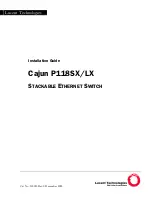
Operating modes and functions
|
|
ELSA LANCOM Business 6000
|
60
EN
The direct descriptions that you can include here will be covered in greater
detail in the following section on the Rules table.
The rules table
In the rules table the objects are linked into filter rules. The rules table
contains the protocol to be filtered (the one you defined in the object table),
the source objects, the target objects and the required filter action.
The protocol and the source or target objects can contain combined objects
and also direct descriptions (e.g. %P6 for TCP), which are separated by '+' or
spaces. A direct description is indicated by '%'. Possible descriptions are:
Similar descriptions can generate lists separated by commas, such as host
lists/address lists (%A10.0.0.1, 10.0.0.2) or ranges separated by hyphens,
such as port lists (%S20-25). Insertion of a '0' or an empty string indicates the
any object:
Host names can only be used if the
ELSA LANCOM Business
can resolve the
names in IP addresses. To do this the
ELSA LANCOM Business
must have
learnt the names via DHCP or NetBIOS, or the assignment must be entered
statically in the DNS or IP routing table. An entry in the IP routing table can
associate an entire network to a host name.
The filter list
The filter list is ultimately put together from the object table and the rule
table. This forms the merge quantity of all filters defined by the rules and
objects.
Description
Function
%A IP
address
%M
Network mask
%S
Sevice (port)
%L
Local network
%H
Host name
%P
Protocol (TCP/UDP/ICMP etc.)
all computers:
%A0.0.0.0
all services:
%S0
all protocols:
%P0
Summary of Contents for LANCOM Business 6000
Page 1: ...ELSA LANCOM TM Business 6000...
Page 4: ...ELSA LANCOM Business 6000 EN...
Page 10: ...Introduction ELSA LANCOM Business 6000 10 EN...
Page 52: ...Connection via 2 Mbit interface ELSA LANCOM Business 6000 52 EN...
Page 110: ...Operating modes and functions ELSA LANCOM Business 6000 110 EN...
Page 162: ...Technical data ELSA LANCOM Business 6000 162 EN...
















































